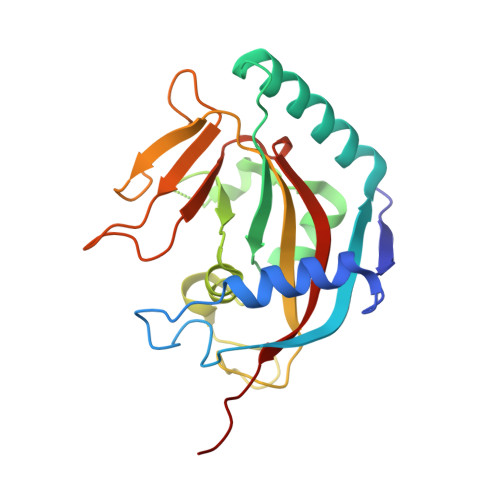Discovery of AZ0108, an orally bioavailable phthalazinone PARP inhibitor that blocks centrosome clustering.
Johannes, J.W., Almeida, L., Daly, K., Ferguson, A.D., Grosskurth, S.E., Guan, H., Howard, T., Ioannidis, S., Kazmirski, S., Lamb, M.L., Larsen, N.A., Lyne, P.D., Mikule, K., Ogoe, C., Peng, B., Petteruti, P., Read, J.A., Su, N., Sylvester, M., Throner, S., Wang, W., Wang, X., Wu, J., Ye, Q., Yu, Y., Zheng, X., Scott, D.A.(2015) Bioorg Med Chem Lett 25: 5743-5747
- PubMed: 26546219
- DOI: https://doi.org/10.1016/j.bmcl.2015.10.079
- Primary Citation of Related Structures:
5EBT, 5ECE - PubMed Abstract:
The propensity for cancer cells to accumulate additional centrosomes relative to normal cells could be exploited for therapeutic benefit in oncology. Following literature reports that suggested TNKS1 (tankyrase 1) and PARP16 may be involved with spindle structure and function and may play a role in suppressing multi-polar spindle formation in cells with supernumerary centrosomes, we initiated a phenotypic screen to look for small molecule poly (ADP-ribose) polymerase (PARP) enzyme family inhibitors that could produce a multi-polar spindle phenotype via declustering of centrosomes. Screening of AstraZeneca's collection of phthalazinone PARP inhibitors in HeLa cells using high-content screening techniques identified several compounds that produced a multi-polar spindle phenotype at low nanomolar concentrations. Characterization of these compounds across a broad panel of PARP family enzyme assays indicated that they had activity against several PARP family enzymes, including PARP1, 2, 3, 5a, 5b, and 6. Further optimization of these initial hits for improved declustering potency, solubility, permeability, and oral bioavailability resulted in AZ0108, a PARP1, 2, 6 inhibitor that potently inhibits centrosome clustering and is suitable for in vivo efficacy and tolerability studies.
Organizational Affiliation:
AstraZeneca R&D Boston, 35 Gatehouse Drive, Waltham, MA 02451, United States.


















